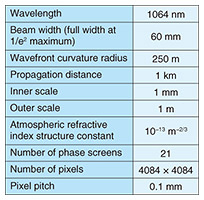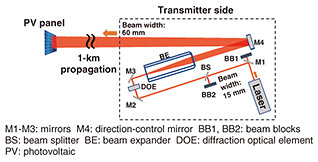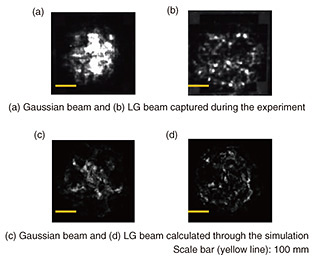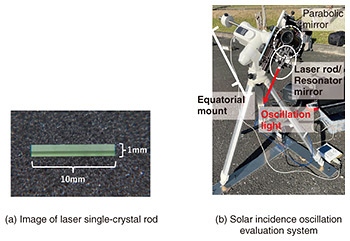 |
|||||||||||||||||||||||||||||||||
|
|
|||||||||||||||||||||||||||||||||
|
Feature Articles: Efforts in the Environmental and Energy Sector to Create a Sustainable and Resilient Society Vol. 22, No. 3, pp. 56–63, Mar. 2024. https://doi.org/10.53829/ntr202403fa6 Long-distance Laser-energy Transmission for Space Solar Power Systems and Their Application on EarthAbstractNTT Space Environment and Energy Laboratories is researching space solar power systems (SSPSs) to enable clean and sustainable next-generation energy. In this article, we explain what an SSPS is and introduce the issues and efforts regarding energy-transmission technology involving lasers, technology to convert sunlight into laser light, and technology to efficiently convert laser light into electric power. Keywords: space solar power system, optical wireless power transmission, laser 1. What is a space solar power system?A space solar power system (SSPS) is a next-generation energy technology that converts solar energy into laser light or microwaves on a geostationary satellite orbiting the Earth, transmits it to the ground, and uses it as power. Since the orbit of a geostationary satellite is 36,000 km above the Earth’s surface, the satellite rarely enters the Earth’s shadow, and unlike conventional solar-power generation, it can generate electricity day and night. Because there is no scattering or absorption by clouds or the atmosphere in space, the energy per unit area of sunlight is expected to be about 10 times that of the ground per year. An SSPS has been attracting attention as a clean and large-scale energy technology using solar energy, regarded as inexhaustible in unobstructed space. Microwave and laser have been proposed as media for transmitting energy from space to the ground. NTT is researching SSPSs using lasers, which have a smaller beam divergence than microwaves and expected to enable system-size reduction. A schematic of this SSPS is shown in Fig. 1. First, solar energy is converted to laser light on a geostationary satellite and transmitted to the ground for 36,000 km. The laser light is then converted to electric power by using photovoltaic devices*1 such as solar cells at a light-receiving facility on the ground. Chemical raw materials such as hydrogen can also conceivably be generated using the energy of laser light on the ground.
We present the challenges and initiatives of the laser-energy-transmission technology necessary for SSPSs. We also describe the research status of technology for solar-pumped lasers and high-intensity beam-energy conversion and introduce examples of these technologies being deployed on the ground.
2. Laser-energy-transmission technology2.1 Diffraction and atmospheric turbulenceIn an SSPS, laser light is propagated from a geostationary satellite to the ground over a distance of 36,000 km. Laser light diffracts, causing beam divergence as it propagates. Since a typical Gaussian beam*2 tends to diverge more the thinner it is, the beam needs to be widened to reduce the beam-divergence angle for long-distance transmission. For example, a beam with a diameter of 1 cm will spread to about 1 km when propagated over 36,000 km, which would require a massive ground-based receiving facility. To suppress beam divergence, the beam diameter of the transmitting side needs to be widened to several meters. The atmosphere from the surface of the Earth up to about 100 km above contains eddies of various sizes, as shown in Fig. 2, causing the refractive index of the atmosphere to change randomly in space and time. When laser light propagates through the atmosphere, the wavefront is disturbed by air eddies, resulting in fluctuations in the intensity distribution of the beam. This is called atmospheric turbulence. If the intensity distribution of the beam fluctuates, there will be a reduction in power generation when converting laser light into electricity with a light-receiving panel consisting of multiple photovoltaic cells, as the light is not evenly projected on the panel [1]. Therefore, it is important to design a beam that is less affected by atmospheric turbulence and an optical system for the light-receiving panel that matches the shape of the beam.
2.2 Simulation of beam propagation through atmosphereTo predict the effect of diffraction and atmospheric turbulence on beam propagation, we conducted beam propagation simulation in the atmosphere. The split-step beam-propagation method effectively reproduces the propagation in a random medium such as atmospheric turbulence. With this method, the propagation is calculated by dividing the propagation optical path into multiple sections by using multiple phase screens, as shown in Fig. 3. By reflecting the refractive-index distribution of the atmosphere in these phase screens, the effect of atmospheric turbulence can be reproduced together with diffraction by normal propagation. To generate a phase screen, we need a spectrum model of the atmosphere. Commonly used models include the Kolmogorov spectrum, von Karman spectrum, and modified von Karman spectrum [2]. The Kolmogorov spectrum is widely used as a basic model, but it lacks accuracy because it does not take into account the size of air eddies that affect the spatial frequency of atmospheric fluctuations. The von Karman spectrum and modified von Karman spectrum, however, can take into account the minimum and maximum size of the air vortex, respectively. In this simulation, the modified von Karman spectrum was used as a spectrum model. This spectrum uses the minimum (called inner scale) and maximum (called outer scale) magnitudes of air eddies as well as a parameter called the atmospheric refractive index structure constant, which represents the strength of the refractive-index change. Typical values of the inner scale are on the order of 1 to 10 mm near the ground surface, and the outer scale usually decreases in proportion to the altitude in the area up to 100 m from the ground [2]. The atmospheric refractive index structure constant usually ranges from 10–17 to 10–13 m–2/3, depending on the season and time. These parameters are assigned to the modified von Karman spectrum, and a phase screen is generated using Fourier transform [3]. Figure 4 shows the beam pattern after atmospheric propagation of the Gaussian beam obtained through simulation (the parameters used in the calculation are listed in Table 1). By propagating through the atmosphere, the intensity distribution of the beam is finely disturbed.
2.3 ExperimentIn an SSPS, laser light is irradiated from a geostationary satellite to the ground to transmit energy, so the transmission direction is vertical to the ground. However, in the vertical direction, it is difficult to ensure the safety of laser light and arrange appropriate test sites. Therefore, we first conducted an energy-transmission experiment in the horizontal direction on the ground in collaboration with Mitsubishi Heavy Industries, Ltd to verify the beam-propagation simulation in the atmosphere and examine the energy-conversion efficiency [4, 5]. In addition to the Gaussian beam with a laser wavelength of 1064 nm, a special beam called the Laguerre-Gaussian (LG) beam*3 was prepared to transmit 1 km in free space and irradiate a 400 mm × 400 mm light-receiving panel (Fig. 5). For long-distance and high-power beam propagation, the effect of aberration*4 of optical elements, such as lenses, and thermal lens effect*5 become problematic. In this experiment, the optical system of both Gaussian and LG beams was designed and adjusted to be about 300 mm when irradiated to the light-receiving panel [3], and a large-diameter lens and low-aberration expander were prepared to prevent aberration. To verify the atmospheric-turbulence simulation, the beam pattern was captured with an infrared camera for 1 min and the intensity distribution was obtained. To examine the transmission efficiency, the power extracted from the light-receiving panel was measured through current-voltage (IV) measurement*6.
Figure 6 shows the experimental and simulation results of the beam pattern after 1-km transmission. In the simulation, the atmospheric structure constant measured during the experiment is used, but the phase screen that reproduces the effect of the turbulence was randomly generated, so the results of the experiment and simulation do not completely match. However, the beam’s shape is generally consistent, such as the size of the beam and disturbance of the intensity caused by the turbulence. When the beam diameter was calculated from the integrated value of the acquired intensity distribution, the error between the experiment and simulation was within 5% for both Gaussian and LG beams [5]. The average value of the center of gravity deviation of the beam calculated in each frame of the video showed an error of 2% between the experiment and simulation [5], indicating that the simulation could accurately reproduce the disturbance in the experiment.
Next, IV measurements were conducted to calculate the energy conversion efficiency. The conversion efficiency of the Gaussian beam and the LG beam was as low as 3% [5]. As can be seen from Fig. 6, this is thought to be due to the intensity distribution of the beam being made non-uniform by atmospheric turbulence, and the light-receiving panel could not be irradiated with uniform laser light. Therefore, a turbulence-robust transmission system is required, such as a beam that can be uniformly irradiated even under atmospheric turbulences and a light-receiving panel that is less affected by variations in the amount of irradiation.
3. Other initiatives at NTT related to SSPSsIn addition to laser-energy transmission, we will introduce the technologies that NTT is researching to enable an SSPS. 3.1 Solar-pumped laserIf a laser device is used as a light source for an SSPS, it is necessary to receive sunlight with a light-receiving panel, convert it into electric power, and generate laser light using the electric power. However, this method involves many energy-conversion processes, which may complicate the system. Therefore, NTT laboratories are studying solar-pumped laser technology, in which solar light is directly irradiated to a laser medium for laser excitation. This technology is expected to reduce the size and weight of the system. Codoped media, such as neodymium and chromium-codoped yttrium aluminum garnet (Nd:Cr:YAG) and neodymium and cerium-codoped YAG (Nd:Ce:YAG), which absorb the energy of sunlight in a wide wavelength spectrum and capable of lasing at a wavelength of 1064 nm, have been investigated as solar-pumped laser media. However, most are made of ceramics, and high-quality single-crystal media have not been reported. In consideration of the possibility of application in space, where heat dissipation is difficult, NTT laboratories are researching single-crystal laser media in collaboration with the Graduate School for the Creation of New Photonics Industries. Thus far, Nd:Cr:YAG single crystals and Nd:Cr:Ce:YAG single crystals have been grown and processed into rod types for lasing (Fig. 7(a)). The authors constructed a system for measuring laser-oscillation intensity by concentrating sunlight on these laser rods with a parabolic mirror and conducted an oscillation experiment outdoors [6] (Fig. 7(b)). As a result of the oscillation experiment, laser oscillation by solar-light injection was confirmed for Nd:Cr:YAG and Nd:Cr:Ce:YAG single crystals. However, compared with the ceramic medium of the same material, both single crystals were below the characteristics of ceramics at the oscillation threshold*7 and slope efficiency*8. In the future, we will analyze the mechanism of laser excitation occurring in a single-crystal medium and investigate a laser medium that has higher oscillation efficiency and suitable for an SSPS.
3.2 High-intensity beam-energy conversionWe are also researching photovoltaic devices that can convert high-intensity laser light from space into electric power on the ground. As mentioned above, in an SSPS, energy of megawatt class is transmitted to the ground with a beam diameter of several meters. To use this energy as much as possible without waste, we are developing a photovoltaic device with high efficiency and high output in collaboration with University of Miyazaki. An indium gallium arsenide phosphide (InGaAsP) photovoltaic device with a high photoelectric conversion efficiency at a wavelength of 1064 nm, which is the assumed wavelength of the laser, has been prototyped, and studies are underway to improve the characteristics of photoelectric conversion and increase the device area. Figure 8(a) shows a device for reducing electrical resistance with an outer-ring electrode. The device was irradiated with 1064-nm laser light using the measuring jig shown in Fig. 8(b), and the power-conversion efficiency was measured. The results are shown in Fig. 8(c). For comparison, the characteristics of a photovoltaic device with mesh-shaped electrodes without outer-ring electrodes are also plotted. The power-conversion efficiency with outer-ring electrodes is up to 27%, indicating that the resistance of the conductor is reduced and the efficiency is improved by using outer-ring electrodes [7]. We will further improve conversion efficiency by improving the anti-reflection coating and electrode design.
When such a semiconductor photovoltaic device is used, however, the photoelectric-conversion efficiency is limited to about 50–60%, and the remainder becomes heat. Therefore, we are also studying ways to use laser energy efficiently in forms other than electricity, for example, by using laser energy as a heat source at extremely high temperatures to generate hydrogen and reduce carbon dioxide to produce fuels and chemical raw materials.
4. Ground useAlthough SSPSs are expected to be commercialized after 2050, we aim to make early contributions to society by applying these elemental technologies on the ground before SSPSs are fully implemented. We believe that power can be supplied to areas such as remote islands where cables are difficult to lay, or disaster-stricken areas where the power grid has been cut off. We are also considering the potential for application to power supplies for mobile bodies such as drones and high altitude platform stations (HAPSs)*9, where miniaturization and weight reduction are key issues. Flight-time limitations and hassle involved in power supply are also factors that restrict applications. Therefore, if energy supply to mobile bodies during flight is made possible with laser-energy-transmission technology, we will be able to minimize the amount of batteries that need to be installed and extend flight time, which suggests a widening of application possibilities.
5. Future workToward developing and implementing SSPSs, we will continue to advance the laser-energy-transmission technology, solar-pumped laser technology, and high-intensity beam-energy conversion technology introduced in this article. Various other technologies are also needed to develop SSPSs, including technology for controlling the attitude of geostationary satellites and accurately beam to ground receiving facilities, and heat-dissipation technology in the vacuum of space. While cooperating with other institutions, we aim to mature these technologies and achieve a sustainable society through SSPSs. We will also promote the early deployment of ground applications such as wireless power-supply systems using laser-energy-transmission technology. References
|
|||||||||||||||||||||||||||||||||





















